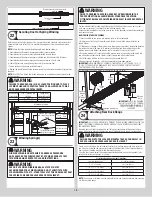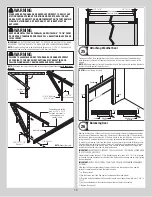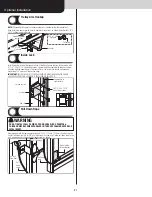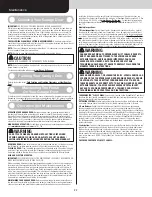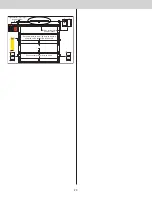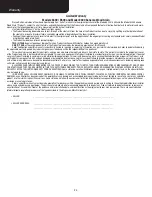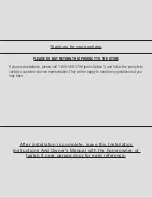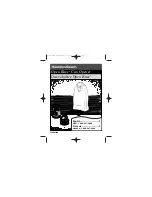
WARNING
MAKE SURE BACK HANGS ARE BRACED SUFFICIENTLY TO RESIST ANY
MOTION DURING SPRING APPLICATION AND DOOR TRAVEL. IF BACK
HANGS PIVOT OR DEFLECT, ADD REINFORCEMENT UNTIL THEY REMAIN
FIRM AND STATIONARY. ANY BACK HANG THAT IS BENT MUST BE
REPLACED.
WARNING
KEEP HORIZONTAL TRACKS PARALLEL AND WITHIN 3/4” TO 7/8” FROM
DOOR EDGE, OTHERWISE DOOR COULD FALL, RESULTING IN SEVERE OR
FATAL INJURY.
IMPORTANT:
DO NOT SUPPORT THE WEIGHT OF THE DOOR ON ANY PART OF THE REAR
BACK HANGS THAT CANTILEVERS 4” OR MORE BEYOND A SOUND FRAMING MEMBER.
NOTE:
If rear back hangs are to be installed over drywall, use (2) 5/16” x 2” hex head lag
screws and make sure lag screws engage into solid structural lumber.
WARNING
FAILURE TO ASSEMBLE AND ATTACH REAR BACK HANGS PROPERLY
ACCORDING TO THE ABOVE INSTRUCTIONS MAY RESULT IN DOOR
FALLING WHEN RAISED, CAUSING SEVERE OR FATAL INJURY.
NOTE:
Perforated angle must be attached to sound framing members and
nails should not
be used
.
90°
(3) 5/16”
Bolts and nuts
(3) 5/16” Bolts and
(3) 5/16” nuts
Perforated
angle
5/16” Hex nut
5/16”-18 x 1-1/4”
Hex bolt
Perforated angle bolted
using (2) 5/16” x 1-5/8”
hex head lag screws to
ceiling member and
parallel to door
Horizontal track
NOTE:
Repeat the same
process for right hand side.
Horizontal tracks
Door edges
3/4” To 7/8”
3/4” To 7/8”
Attaching Weather Seal
25
Permanently attach the weatherstrips on both door jambs and header. The weatherstrips
were temporarily attached in Preparing the Opening, in the pre-installation section of this
manual.
NOTE:
When permanently attaching the weatherstrips to the jambs, avoid pushing the weath-
erstrips too tightly against the face of door.
Weather seal
s
Nail
Weather
seal
Jamb
Weather seal
installed
Jamb
Header
Jamb
Nail
NOTE:
Door not shown for clarity.
Balancing Door
26
Remove locking pliers. Lift door and check its balance. Adjustments to the required number
of spring turns stated may be necessary. If door rises off floor more than 2 ft. under spring
tension alone, reduce spring tension. If the door is hard to rise or drifts down on its own, add
spring tension. A poorly balanced door can cause garage door operator problems.
To adjust spring tension, fully close door. Apply locking pliers to track above third track roller.
Place locking pliers on torsion shaft, as shown in Step Attaching Counterbalance Lift Cables.
Insert a winding rod into the winding cone. Push upward on the winding rod slightly while
carefully loosening the set screws in the winding cone.
IMPORTANT:
BE PREPARED TO SUPPORT THE FULL FORCE OF THE TORSION SPRING ONCE
THE SET SCREWS ARE LOOSE.
Carefully adjust spring tension 1/4 turn. Retighten both set screws to 14-15 ft. lbs. of torque
in the winding cone and repeat for the other side. Recheck door balance and re-adjust spring
tension if needed.
IMPORTANT:
DO NOT ADJUST MORE THAN 1 TURN FROM THE RECOMMENDED NUMBER
OF TURNS.
If the door still does not operate easily, lower the door into the closed position, unwind
spring(s) completely, and recheck the following items:
1.) Is the door level?
2.) Are the torsion shaft and flag angles / angle mount level and plumb?
3.) Does the distance between the flag angles / angle mount equal door width plus 3-3/8” to
3-1/2”?
4.) Do the counterbalance lift cables have equal tension? Adjust if necessary.
5.) Rewind the spring(s).
19
Summary of Contents for 8300
Page 25: ......














